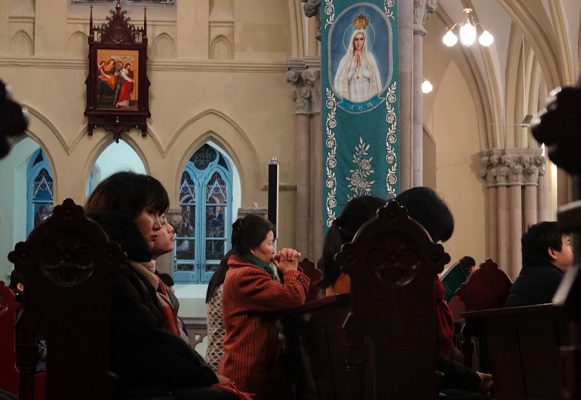
Xujiahui Cathedral, also known as St. Ignatius Cathedral of Shanghai, was filled with people on Saturday as it hosted its first Mass after a two-year restoration project.
With two parallel bell towers soaring to the sky, the 57-meter-high cathedral is one of the most eye-catching structures in Shanghai’s bustling Xujiahui area. It is a spiritual home for thousands of Catholics in the city.
The cathedral was designed by English architect William Doyle and built between 1906 and 1910. Over the past century, it has hosted worshippers and drawn countless tourists.
“My home was near the cathedral, and I’ve been coming to services since I was a child,” Yu Wenjuan, 70, said at the early-morning Mass.
“Not much has been changed. I saw they replaced the glass, and I’m glad to know they fixed the leaky roof.”
Wei Wei, chief designer at Yuangou Architects & Consultants, who participated in the restoration, said his team checked many historic documents and photos during the planning process. The aim was to retain the cathedral’s original features.
The restoration started in 2015. The main exterior tasks included replacing cracked red bricks on the walls, fixing leaks in the roof and repainting the roof tiles.
Carved stone statues of animals under the cornice, which had suffered wind abrasion, were also restored.
The cathedral’s interior walls were refurbished and the stained glass was replaced.
TV screens and an audio system were added, and people in every corner of the nave, which holds up to 3,000, can clearly see and hear the Mass.
Although the restoration project is complete, the cathedral is not yet ready for tourists. It is open for religious activities only, said Gu Zhangjun, diocese priest.
“We still need some time to make sure everything runs well after the restoration,” he said.
The cathedral is one of the main attractions in the city’s Xujiahui area, where a dozen historic sites are preserved, including the Xujiahui bibliotheca (library) built in 1847, an observatory built in 1872 and a memorial hall for a renowned Chinese scholar, Xu Guangqi, of the Ming Dynasty (1369-1644). The area was designated a national 4A tourist site in 2012.


